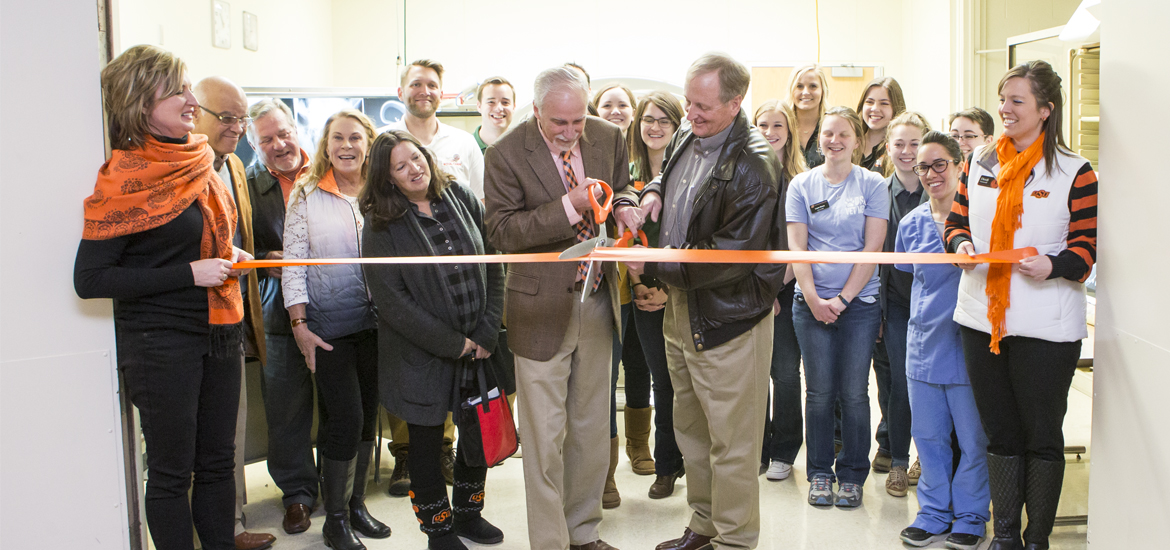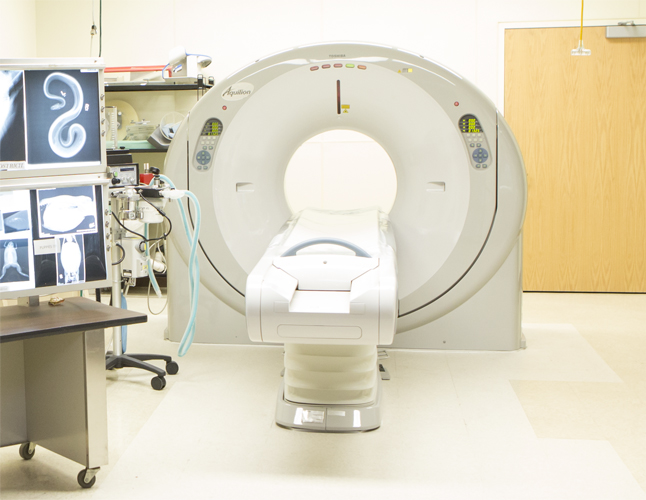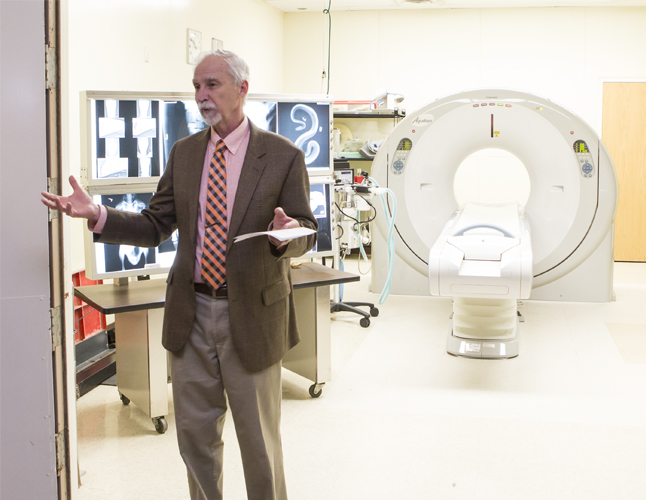
A New Look
Wednesday, August 1, 2018
Veterinary hospital’s upgraded CT scanner provides sharper images and better diagnoses
When your patients can’t speak, more options are vital for determining what’s wrong with them. And none of the patients at OSU’s Veterinary Medical Hospital can speak.
But the hospital recently got more help in this area when it upgraded its CT scanner from a four-slice model to a 64-slice unit.
Dr. Carrie Kuzma, a clinical instructor in radiology in the Department of Veterinary Clinical Sciences, detailed the benefits of the new scanner.
“This machine provides shorter scan times, less anesthesia, less anesthetic time and better image quality,” she said. “The four-slice scanner was much slower with its scanning time and was more susceptible to artifacts or distortions and motion from the patients. This required nearly all patients to be under general anesthesia for their scans.”
Today is different: “We get our scans done in half the time or even less. We are capable of doing more patients under heavy sedation versus complete general anesthesia. Also, the new machine is less susceptible to motion and artifacts.”

OSU’s hospital takes referrals from veterinarians across Oklahoma and the region.
“It’s important that our referring veterinarians know that we have the 64-slice CT scanner,” she said. “It is up and running and available. We have it for small animals, large animals and exotic animals.”
According to Kuzma, the radiology team is now getting patients into surgery sooner.
“If a patient needs surgery, we can scan them in a quarter of the time compared to the four-slice CT scanner. Then they are off to surgery, which allows the surgeons to get things done quicker because the patient is ready faster. We can also deliver patients quicker to ultrasound for fine needle aspirations that help with medicine cases.
“I think one of the biggest things that we are able to do now is look at more coronary arteries around the heart. We are able to see them in better definition. With the 64-slice we see a lot of those little, finer structures a bit better. Having the 64-slice CT scanner just helps overall with the diagnosis of patients.”
Drs. Bob Shoup and Steve Weir of Catoosa Small Animal Clinic were among the supporters of this project.
“We gave in recognition of the wonderful career and work that Dr. Mark Neer (who recently retired) did for the profession and the university,” Shoup said. “Plus, advanced imaging is a must for referral centers. The 64-slice CT will improve imaging and diagnostic capabilities.
“However, machines are just machines unless you have people who can run the test, interpret the results correctly, and then give treatment options. OSU’s Veterinary Medical Hospital has the people in place who can utilize the new CT to its fullest capacity. Obviously, CT scanners are too expensive for the average veterinary clinic. That is why it is important that we have them easily accessible for our clients.”
As with any new piece of equipment, the 64-slice CT scanner comes with a learning curve.
“It’s a more complicated system because it is a 64-slice versus a four-slice machine,” Kuzma explained. “Once you learn the system and the machine, it becomes easier and faster to run. The technicians become more efficient and more proficient the more they use it.”
Kuzma estimated that maybe one or two other veterinary practices in Oklahoma have a 64-slice CT scanner.

“That’s going to depend on how many specialty practices there are, their caseload and what they have decided to use for equipment,” Kuzma said. “I would say about 30 percent of veterinary colleges in the country have a 64-slice CT scanner. Some are still using either an eight-slice or a 16-slice. Once their equipment comes to end of life, their upgrade will more likely be to a 64-slice.”
Marla and John Palovik are grateful clients of OSU’s Veterinary Medical Hospital who were referred by Dr. Shoup.
“Our beloved Cavalier King Charles spaniels, Mattie and Alice, had mitral valve heart disease, as many Cavaliers do,” Marla Palovik said. “Dr. Shoup had done and tried all he knew to do with medications and treatment. He referred us to OSU’s veterinary cardiologist, Dr. Ryan Baumwart, in late 2016 for his expertise. Despite seeing some improvement in their health, we had to let the girls ‘go’ in December 2016. Due to the care and concern given us, we decided to make a first-time donation in memory of Mattie and Alice shortly after they passed away.
“Months later, Dr. Shoup mentioned the 64-slice CT scanner the hospital was trying to acquire. We decided to make a second donation earmarked specifically for the CT, knowing the advanced technology of the new 64-slice CT would benefit both small and large animals and meet critical medical needs of many more patients in a shorter period of time than with the original, older CT machine. We were honored to attend the Center’s Open House and dedication of the new CT scanner earlier this spring.
“We would not hesitate to bring our future pets to OSU’s Veterinary Medical Hospital again, or to refer others as well. If lives can be saved or medically improved, this is the place to be.”
“If we want OSU to be a great referral center, it is critical that we make sure they have the best equipment available,” Shoup said. “It is also important to train tomorrow’s veterinarians on the latest technology so they can be their best when they graduate.”
“On behalf of the entire radiology department, thank you to everyone who supported the purchase of this machine and helped us upgrade our technology,” Kuzma said.
